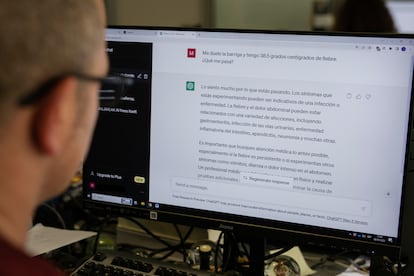How to use ChatGPT: A step-by-step guide
To enter the era of generative artificial intelligence, with the help of the most popular chatbot, just register using an email and start asking questions

ChatGPT burst onto the scene with overwhelming success: just two months after its launch in November 2022, it had reached 100 million unique monthly users worldwide, becoming the fastest growing platform in the history of the internet. Today, that number has swelled to 180 million users, who use the chatbot to ask questions, for recommendations and to create text, among other uses. Using ChatGPT is as simple as signing up and learning how to ask the right questions.
The first step is to go to the ChatGPT website and click on the “Sign up” button. To create an account, you just need an email address and a password. It’s free and takes just a few seconds. If you sign out, the next time you enter the page, you will be asked to enter these login details.
Once you have logged in, a screen opens with a dialog box at the bottom, where you can type your questions. Unlike traditional chatbots, ChatGPT does not just give an automated response: it uses a learning system that can interpret what is being asked and create new and unique content to respond to that question. In this way, it can be used to create dialogs, generate automatic content and to improve texts for different purposes.
Every question that you ask ChatGPT is stored in a history that appears in a left-hand column, meaning you can retrieve past answers at any time just by clicking on the question. Each query also helps OpenAI — the company that created ChatGPT — to continue training the chatbot. If you do not want your questions to be stored, you can activate a temporary chat — an option located in a drop-down tab at the top left.
There are at least three other functions that are important. Firstly, you can use the chatbot to summarize documents or respond to questions about the contents. To do this, you just need to upload the document to the dialogue box by clicking the paper file icon or by giving it access via the cloud. All files that are shared with ChatGPT are stored in its database and used again to train the AI system.
Secondly, you can use customized versions of ChatGPT for specific tasks: anyone can develop their own based on their technology, and then share it with the rest of the world. So, for example, some users have created versions for improving productivity, for research and for educational purposes. To find these and other options, click on “Explore GPTs” in the left-hand column.
And the third feature to be aware of is the Templates option, which is located at the bottom of the left-hand column. The first thing to know is that ChatGPT works on the basis of prompts, i.e. instructions. Although it is true that it will answer any question, however it is asked, to get the most accurate answer possible, it is a good idea to know how to frame the question. And this is where the Templates section can be of great help. You select the topic and what you hope to learn about it, and the system creates an editable draft of the ideal prompt for this goal.
Sign up for our weekly newsletter to get more English-language news coverage from EL PAÍS USA Edition
Tu suscripción se está usando en otro dispositivo
¿Quieres añadir otro usuario a tu suscripción?
Si continúas leyendo en este dispositivo, no se podrá leer en el otro.
FlechaTu suscripción se está usando en otro dispositivo y solo puedes acceder a EL PAÍS desde un dispositivo a la vez.
Si quieres compartir tu cuenta, cambia tu suscripción a la modalidad Premium, así podrás añadir otro usuario. Cada uno accederá con su propia cuenta de email, lo que os permitirá personalizar vuestra experiencia en EL PAÍS.
¿Tienes una suscripción de empresa? Accede aquí para contratar más cuentas.
En el caso de no saber quién está usando tu cuenta, te recomendamos cambiar tu contraseña aquí.
Si decides continuar compartiendo tu cuenta, este mensaje se mostrará en tu dispositivo y en el de la otra persona que está usando tu cuenta de forma indefinida, afectando a tu experiencia de lectura. Puedes consultar aquí los términos y condiciones de la suscripción digital.











































